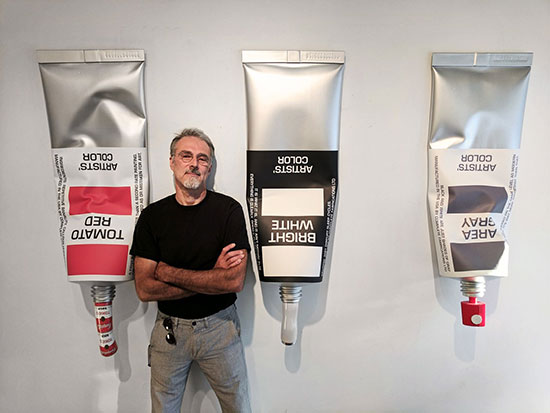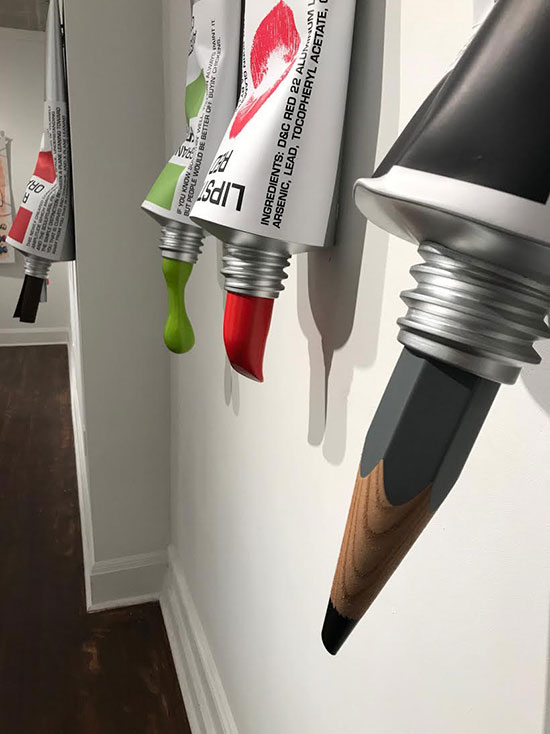A collection of large-scale paint tubes—accompanied by mammoth imitations of jottings and sketches on lined paper pinned up by colossal thumb tacks—line the walls of one of the front exhibition spaces at Monika Olko Gallery in Sag Harbor, NY. The wall sculptures by Miles Jaffe are featured in the artist’s solo show presenting works from two ongoing series: “Artists’ Color” and “Notes to Self.”
Works in “Artists’ Color” contemplate the relationship between artist, medium and product through a series of 20 sculptures in the form of paint tubes meant to represent popular culture, according to Jaffe. “Notes to Self” opens a window into the artist's mind through wall sculptures in the shape of oversized notebook papers and a coupon replica with text portraying handwritten fabrication notes, unrealized plans and hidden neuroses.
.

Artist Miles Jaffe with his "Artists' Color" series installed at Monika Olko Gallery in Sag Harbor, NY. Photo by Christian Di Lalla. Courtesy of the artist.
.
“‘Artists’ Color’ and ‘Notes to Self’ can reach people visually, literally, or conceptually and that’s what I like; art that makes me think, makes me question,” said Jaffe. The oversize paint tubes and notepaper have a strong visual impact on viewers, he said and pointed out, “People can look at that and say, ‘Isn’t that cool?’” Meanwhile, the different pigments and text on each tube offer a puzzle for the viewer and another layer of insight into the artist’s perspective, he said.
.

"Notes to Self" Installation at Monika Olko Gallery, Sag Harbor, NY 2017. Courtesy of the artist.
.
His work explores the meaning of art and the impact of its co-dependency with money to bestow value, according to the artist.
“Art has always been about commerce,” Jaffe declared, citing practices in art history of valuing the art's selling price according to materials used. Gold and lapis, when part of the art, would typically increase its worth, he said. “This is the notion underlying my point of view,” Jaffe explained. If art and commerce are inextricably entwined, he questions, then what is the nature of art?
Jaffe described the oversized paint tubes as a parody, and in turn, a tribute to many legendary predecessors including Claude Monet, Banksy, Roy Lichtenstein and Andy Warhol, among others.
.

"4C Process" by Miles Jaffe, 2016. Metal, Polymer, Pigment, 58 x 19 x 12 inches. Courtesy of the artist.
.
Tomato Red, a four and a half foot-long tube labeled with that color name and a sharp photo of a ripened tomato, is bent and distorted much like a toothpaste tube, reflecting the squeezing out of its contents. It appears as though Campbell’s Soup cans are coming out of the tube, an ode to Andy Warhol’s 32 Campbell's Soup Cans, which poked fun at the relationship between art, commercialism and popular culture. Jaffe’s paint tubes are a literal query: can art actually be squeezed out?
In Rust Orange, the paint tube expels a rust-colored concave form. The text on the tube draws from Richard Serra's defense of his sculpture Tilted Arc, a verbose and decidedly rambling excerpt on the meanings people ascribe to different shapes. Jaffe juxtaposes these words with a blunt one-liner by author Harry Frankfurt from his essay, “On Bullshit.” Jaffe’s commentary is implicit in his pairing of the contrasting voices.
For Jaffe, using paint tubes as a medium for questioning the nature of art and value evolved from a chance encounter. A longtime friend asked Jaffe for a second opinion on potential acquisitions at an art fair, he recalled. Ceramic paint tubes piqued their interest, but although the three-dimensional nature of the tubes and bright color schemes were eye-catching, something was amiss for Jaffe. He urged his friend to let him come up with something instead.
“This was the trigger, the point of departure to make it into something different,” said Jaffe. He started generating ideas. “I had to establish a context that made sense in my world,” he said. He expanded on the visual intrigue of paint tubes, and introduced new meaning. Gamma Green, alluding to The Hulk, was among the first models, and became a prototype for the “Artists’ Color” series.
Miles Jaffe is a trained industrial designer with a BFA from Rhode Island School of Design who approaches process in a thorough and thoughtful manner. “I’ve been building things for as long as I can remember,” he said. “Advanced technology comes along like magic for people; I wanted to understand it.” He gained invaluable experience working in the office of his late father, the world-renowned architect Norman Jaffe (1932-1993), on his way to becoming a designer who takes a wide range of creative projects, from art and architecture to furniture and new media.
“My bed was a drafting board,” said Jaffe, “it was my playground.” Norman Jaffe introduced his son to art, most influentially, the large-scale sculptures of Claes Oldenburg. The father’s visceral response to design diverged from Miles’s methodical approach, Miles said, a divergence that “amplified in our creative process and influence on each other.”
.

"Perforated Page, With Coffee" by Miles Jaffe, 2016. Metal, Polymer, Pigment, 50 x 30 x 8 inches. Courtesy of the artist.
.
Miles sees an architectural connection to his art but only a cursory one. “‘Artists’ Color’ is only architectural in the sense that it is very well planned from concept, the rules of fabrication are established,” said Jaffe, referring to the fixed set of architectural elements that need to be incorporated when designing an inhabitable building, such as walls, a roof and at least one door. Producing the sculptures in both “Artists’ Color” and “Notes to Self” is a multi-step process that includes creating molds, making watercolor paintings, fabricating the sculpture from sheet metal and 3-D printing to bring it all to life—a process Jaffe is involved in from start to finish as a specialist in both design and execution.
“Artistic freedom,” he said, “is revealed in the paint’s drip, the text, the condition of the tube.” When Jaffe approaches his artwork, he views himself as the client. A client, he noted, inherently has restrictions such as function and budget. “There is a box you must create in,” he said. “In my own work, I have to establish the box. The relevant body of work relates to itself.”
Some of the paint tubes in “Artists’ Color” began with the name of the color. Then Jaffe elaborates by asking himself, “What reference can I make to art?” Within his established rules of form, he seeks to merge graphic balance and visual meaning.
“There are levels of interest,” the artist said, related to the shape of the tubes, the artists referenced, the text, the context and Jaffe’s own commentary. “I know it’s a homerun when people look at something and smile," he said. "It doesn’t get better. We need to enjoy ourselves.”
.

"Miles Jaffe — Solo Exhibition" at Monika Olko Gallery, Sag Harbor, NY 2017. Courtesy of Monika Olko Gallery.
.
Area Gray, a pigment tube topped with a red aerosol nozzle, is Jaffe’s tribute to the graffiti artist Banksy. The paint tube’s text label is Banksy’s own quote: “Should graffiti be judged on the same level as modern art? Of course not: it’s way more important than that.” The chosen pigment for this paint tube refers to painting on gray area; its significance to Jaffe’s quest in “Artists’ Color” is that street art is about accessibility. By its public nature and its anonymous makers, graffiti and street art belongs to everyone and no one, all at once. Jaffe’s sculpture asks viewers to consider if graffiti is an art form that is finally detached from commerce.
Jaffe references Jeff Koons’s banal sculptures and their high market value in his sculpture where doodles of blue balloon dogs appear on large sheet metal formed to look like perforated pages ripped out of a notebook. “The notes are more caustic,” Jaffe said of his series. “My entire life experience is in this work. It reflects my worldview: commerce drives everything.”
The artist’s True Green paint tube, which squeezes out dollar bills, is perhaps the most vivid caricature of his role as artist and critic, at once grim and playful. “I’m only happy when I’m making something,” he said with a smile. “The rest of the time I’m miserable.”
.

"True Green" by Miles Jaffe, 2016. Metal, Polymer, Pigment, Paper, 54 x 19 x 12 inches. Courtesy of the artist.
.
__________________________
BASIC FACTS: “Miles Jaffe — Solo Exhibition” is on view August 19, 2017 to September 26, 2017 at Monika Olko Gallery, 95 Main Street, Sag Harbor, NY 11963. www.monikaolkogallery.com
__________________________
Copyright 2017 Hamptons Art Hub LLC. All rights reserved.
